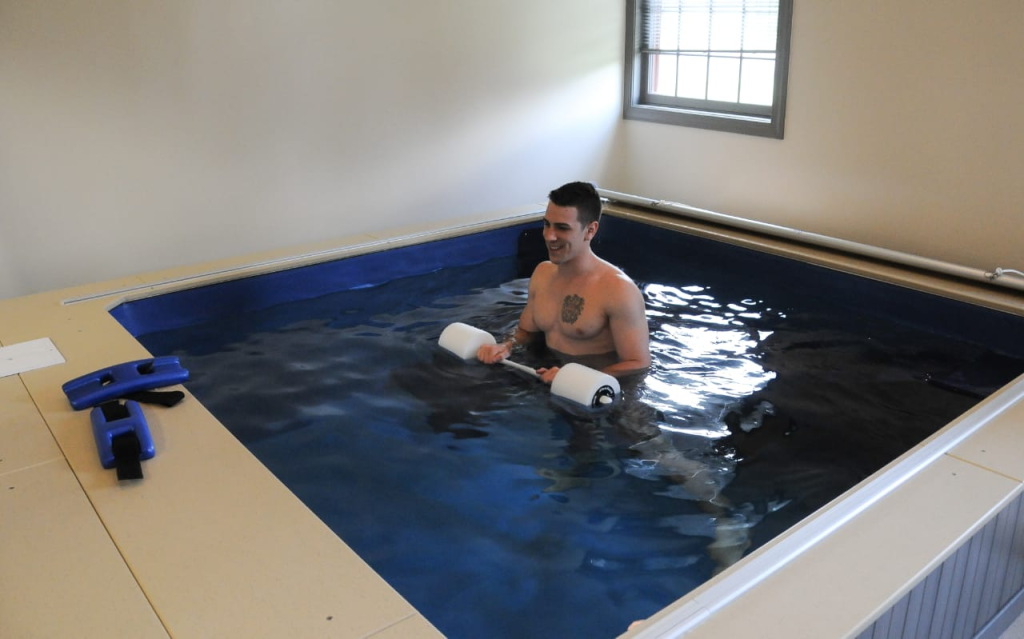
Hydrotherapy and aquatic therapy have become vital tools for helping athletes recover from sports injuries. Hydrotherapy uses water for therapeutic purposes, while aquatic therapy involves doing exercises in a controlled pool with guidance from professionals.
This rise in interest is because of water’s many benefits for recovering from sports injuries. Water’s buoyancy helps ease joint stress, and its pressure can improve healing. Plus, being in the water can calm the mind, which is just as crucial for recovery as the physical benefits.
In this exploration, we’ll dig into these benefits and how they work. By understanding how water therapy helps, athletes can make the most of it and return to performing their best.
Table of Contents
ToggleII. Understanding Aquatic Therapy
Aquatic therapy operates on principles tailored for sports rehabilitation, utilizing water’s unique properties to aid healing. In this context, it involves structured exercises in a controlled pool setting under expert supervision. Water’s properties—buoyancy, hydrostatic pressure, and resistance—are critical in its therapeutic application.
Buoyancy in water significantly reduces the impact on an athlete’s body, allowing exercises with minimal strain on injured areas. This buoyant force supports joints and lessens the load on muscles, facilitating movement without exacerbating injuries.
Hydrostatic pressure, another crucial aspect, improves blood circulation. This enhanced circulation delivers nutrients and oxygen to injured tissues, fostering quicker recovery while reducing swelling and inflammation.
III. Benefits of Aquatic Therapy for Athletes
Aquatic therapy offers a multitude of benefits specifically tailored for athletes undergoing rehabilitation:
Reduced Impact, Enhanced Healing:
The buoyancy of water significantly reduces the impact on an athlete’s body during exercises, allowing for movement without the usual strain. This promotes healing by minimizing stress on injured areas.
Improved Circulation and Healing:
Hydrostatic pressure in water enhances blood circulation, delivering vital nutrients and oxygen to injured tissues. This not only expedites the healing process but also reduces inflammation and swelling.
Enhanced Flexibility and Range of Motion:
Immersion in warm water relaxes muscles, reducing stiffness and increasing flexibility. Athletes can perform exercises that improve their range of motion without the resistance experienced on land.
Resistance Training Without Strain:
Water’s resistance facilitates muscle strengthening without the strain of high-impact exercises. This aids in rebuilding strength gradually, which is crucial for rehabilitation.
Psychological Well-being:
Aquatic therapy induces a calming effect, reducing stress and anxiety often associated with injury rehabilitation. This psychological respite complements the physical benefits.
IV. Accelerated Healing and Recovery
Specific Injury Rehabilitation:
Aquatic therapy demonstrates efficacy in rehabilitating various injuries, including ACL tears, shoulder injuries, and more. Through reduced impact and buoyancy, it enables controlled movements, potentially aiding early-stage rehabilitation without excessive strain on injured areas.
Enhanced Circulation and Healing:
Hydrostatic pressure in water improves circulation, delivering nutrients to injured tissues. This may accelerate healing, reducing inflammation and swelling commonly associated with sports injuries.
Early Engagement in Rehabilitation:
The reduced impact of water allows athletes to engage in rehabilitation exercises sooner post-injury. This early engagement helps maintain muscle strength and joint flexibility, preventing the loss of conditioning during recovery.
Comparison with Land-Based Therapy
● Speed of Recovery: Aquatic therapy, with its reduced impact and joint stress, hypothetically accelerates early-stage recovery compared to land-based therapy. However, the targeted exercises in land-based treatment might become more effective in building specific muscle strength as rehabilitation progresses.
● Impact on Joints: Aquatic therapy offers a gentler environment for movement, reducing stress on joints. Conversely, land-based therapy might exert more pressure on joints due to gravity.
● Muscle Strengthening and Specificity: Land-based therapy allows targeted muscle-building resistance exercises. Aquatic therapy offers resistance differently, aiding muscle strengthening without excessive joint stress.
V. Specific Applications in Sports Rehabilitation
Here are specific applications of aquatic therapy in sports rehabilitation:
ACL Tears
Early Mobilization:
Aquatic therapy allows for controlled movements like leg raises in water, aiding early-stage rehabilitation without excessive strain on the injured ACL.
Muscle Strengthening:
Water-based resistance exercises, such as gentle swimming motions or knee bends, may aid in strengthening surrounding muscles without imposing excessive stress on the healing ACL.
Shoulder Injuries (Rotator Cuff Tears, Shoulder Dislocations)
- Range of Motion Exercises: Aquatic therapy’s reduced joint stress enables gradual and controlled movements that can help restore shoulder flexibility and range of motion.
- Strengthening and Stability: Water resistance allows for gentle yet effective exercises targeting shoulder muscles without compromising stability, aiding in restoring strength.
Ankle Sprains
- Balance and Proprioception Training: Aquatic therapy provides a stable environment for practicing balance exercises, helping athletes regain proprioception without risking re-injury.
- Gradual Weight-Bearing: The buoyancy of water allows for controlled weight-bearing exercises, facilitating gradual recovery without subjecting the ankle to full impact.
Low Back Pain
- Core Strengthening: Aquatic therapy offers a supportive environment for core-strengthening exercises, as water provides resistance without the strain often experienced on land.
- Improved Flexibility: The warmth and buoyancy of water aid in relaxing muscles, potentially reducing low back pain and increasing flexibility for targeted exercises.
VI. Designing an Effective Aquatic Therapy Program
Here’s a condensed breakdown of each step in designing an effective aquatic therapy program:
Assessment and Goal Setting
● Initial Evaluation: Assess the athlete’s injury, movement, strength, and limitations to understand their current state.
● Goal Identification: Set achievable and measurable goals aligned with the athlete’s desired outcomes and recovery timeline.
Program Development
● Exercise Selection: Choose gentle, injury-specific exercises, gradually progressing as the athlete heals.
● Utilizing Water’s Properties: Leverage water’s buoyancy and resistance for low-impact, effective strength-building and flexibility exercises.
Implementation and Monitoring
● Professional Supervision: Ensure sessions are guided by trained professionals for safety and proper technique.
● Progress Monitoring: Regularly track the athlete’s progress and adapt the program accordingly based on their response and changes in their condition.
Integration with Other Therapies
● Complementary Therapies: Combine aquatic therapy with land-based methods or strength training for a comprehensive approach.
● Transition Plan: Develop a smooth transition strategy from aquatic therapy to land-based exercises as the athlete nears recovery completion.
Education and Follow-Up
● Athlete Education: Educate the athlete on exercises, benefits, and how aquatic therapy aids their recovery.
● Home Program: Guide independent exercises in the pool or at home to support clinic sessions.
● Follow-Up Care: Conduct periodic check-ins post-program to maintain progress and prevent future injuries.
VII. Success Stories and Testimonials
Success Story: Recovering from ACL Tear
Athlete: Sarah K.
“After tearing my ACL during a game, I thought my season was over. But aquatic therapy changed everything. Under expert guidance, I started gentle movements in the pool. The water’s support allowed me to exercise without stressing my injury. Gradually, I regained strength and flexibility. Thanks to aquatic therapy, I’m back on the field stronger than before!”
Testimonial: Shoulder Injury Rehabilitation
Athlete: Mark T.
“A shoulder injury nearly derailed my career. Aquatic therapy became my game-changer. The water’s buoyancy and resistance worked wonders. It helped me rebuild shoulder strength without overexerting. I’m grateful for the personalized aquatic therapy program that led me to a full recovery and back to competition.”
VIII. Future of Hydrotherapy in Sports Medicine
The future of hydrotherapy in sports medicine appears promising, with continued advancements in tailored rehabilitation programs. Innovations integrating technology, such as underwater cameras for form correction or AI-driven personalized exercise regimens, will likely emerge. Research exploring the optimal use of water’s properties for injury prevention and performance enhancement will drive its evolution. Hydrotherapy’s role as a pivotal adjunct to traditional rehabilitation methods is set to expand, offering athletes more effective and customized strategies for injury recovery, conditioning, and overall sports performance enhancement.
IX. Conclusion: Harnessing Aquatic Therapy for Athletes
In conclusion, total performance physical therapy emerges as the go-to solution for athletes seeking to harness the full potential of aquatic therapy. This comprehensive approach integrates aquatic therapy as a cornerstone, offering a holistic framework beyond mere recovery.
Total performance physical therapy addresses injury rehabilitation and focuses on enhancing an athlete’s overall performance. By incorporating aquatic therapy into this approach, athletes benefit from its unique properties—reduced impact, improved circulation, and targeted exercises—tailored to their needs.
This holistic approach enhances an athlete’s overall performance by expediting recovery and maximizing strength, flexibility, and endurance. Total performance physical therapy is dedicated to attaining peak athletic conditions, prioritizing injury recovery and optimal on-field or court performance.
More Stories
Discover Affordable Property for Sale in Malta Under 100K Your Guide to Smart Investment
Malta, with its rich history, stunning Mediterranean coastline, and vibrant culture, has long been a sought-after destination for real estate...
The Role of Digital Marketing in Growing Your Business
In the modern business landscape, digital marketing is no longer an optional strategy—it is essential for the growth and success...
How to Increase Online Visibility with a Strategic SEO Plan
In today’s digital world, where businesses and brands are constantly vying for attention, an effective SEO (Search Engine Optimization) strategy...
Spartan Capital Securities LLC: A Full-Service Brokerage with a Client-Centric Approach
Spartan Capital Securities LLC has carved out a notable presence in the financial services industry. As a full-service brokerage and...
How to Protect Yourself from Chemical Runoff in Tap Water
Our water supply is increasingly at risk of contamination from chemicals used in homes, farms, and industries. While water treatment...
QR Scanner Technology Explained: How It’s Changing the Way We Make Contactless Payments
In today's fast-paced, tech-driven world, the need for quick, efficient, and secure payment methods has never been more crucial. Enter...


